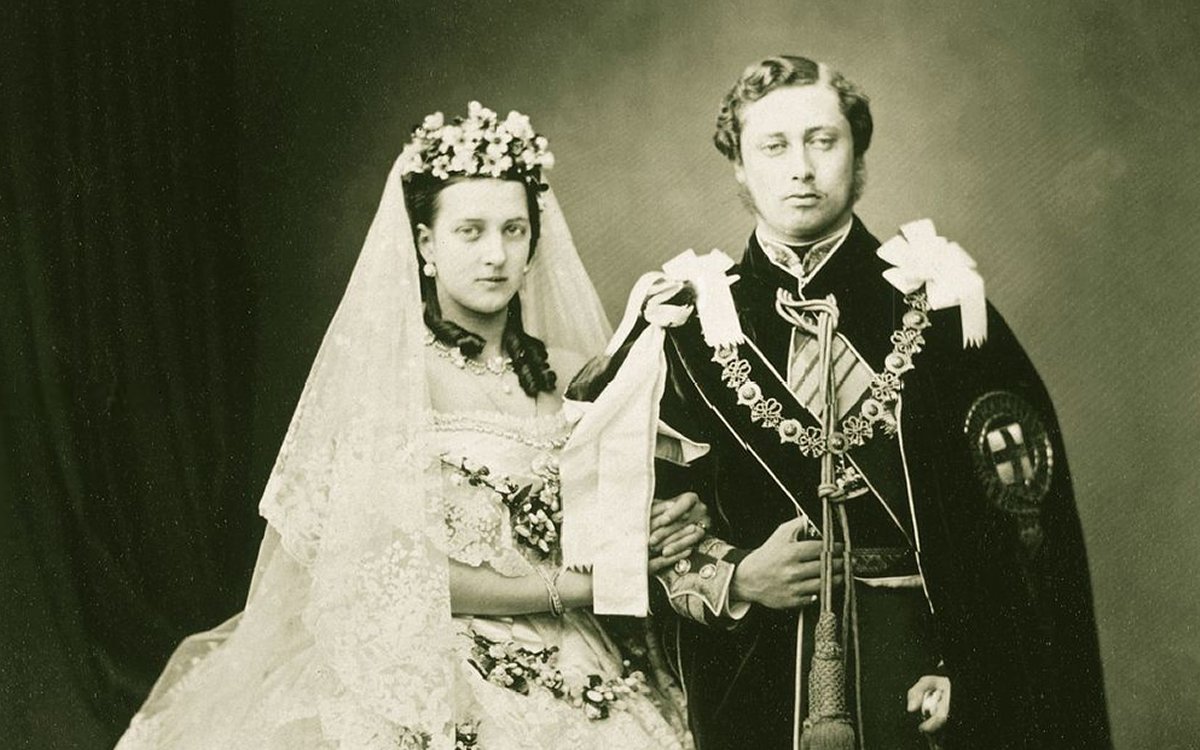
This week’s Wedding Tiara Wednesday is, well, another royal wedding without a tiara. We’ve got a closer look today at the jewels worn 160 years ago this week by Queen Alexandra of the United Kingdom, including the tiara that she decided not to wear for her wedding ceremony.
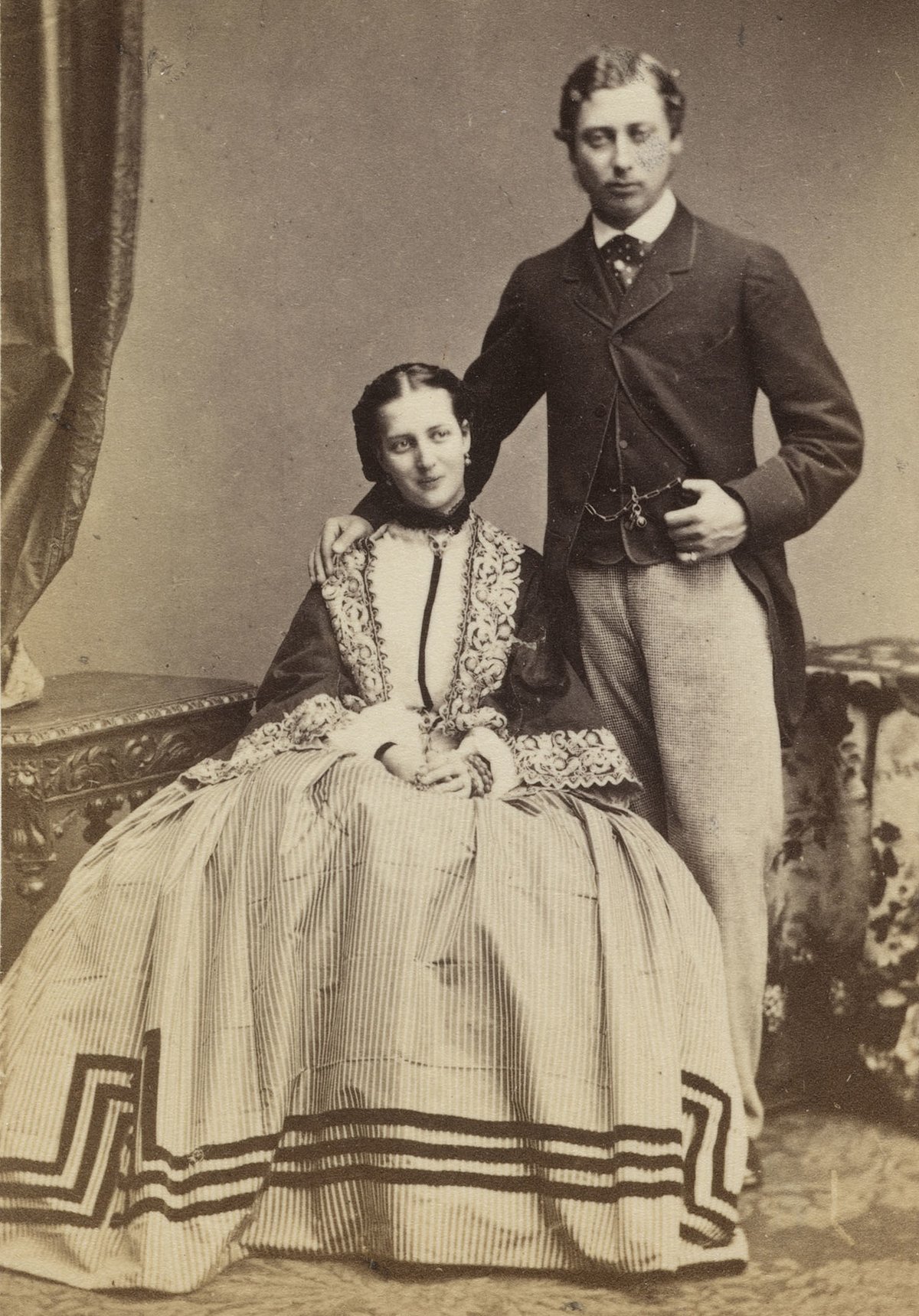
In September 1862, it was announced that the Prince of Wales, eldest son of Queen Victoria, would marry Princess Alexandra, daughter of the future King of Denmark. The couple had met a year earlier in an encounter arranged by his elder sister, the Crown Princess of Prussia. Almost a year later, following the traumatic death of his father, the Prince Consort, Bertie proposed to Alix at Laeken, the Belgian castle occupied by his great-uncle, King Leopold I.
Alix arrived in England a few days before the royal wedding, which was scheduled to take place at St. George’s Chapel, Windsor rather than the more usual location of the Chapel Royal at St. James’s Palace in London. Queen Victoria insisted on the change of venue, arguing that it was the wish of the late Prince Albert that Bertie’s wedding should take place there. But many believed that the widowed and increasingly reclusive monarch wanted the wedding to be at St. George’s Chapel because she could watch the ceremony from above the proceedings in Catherine of Aragon’s closet.
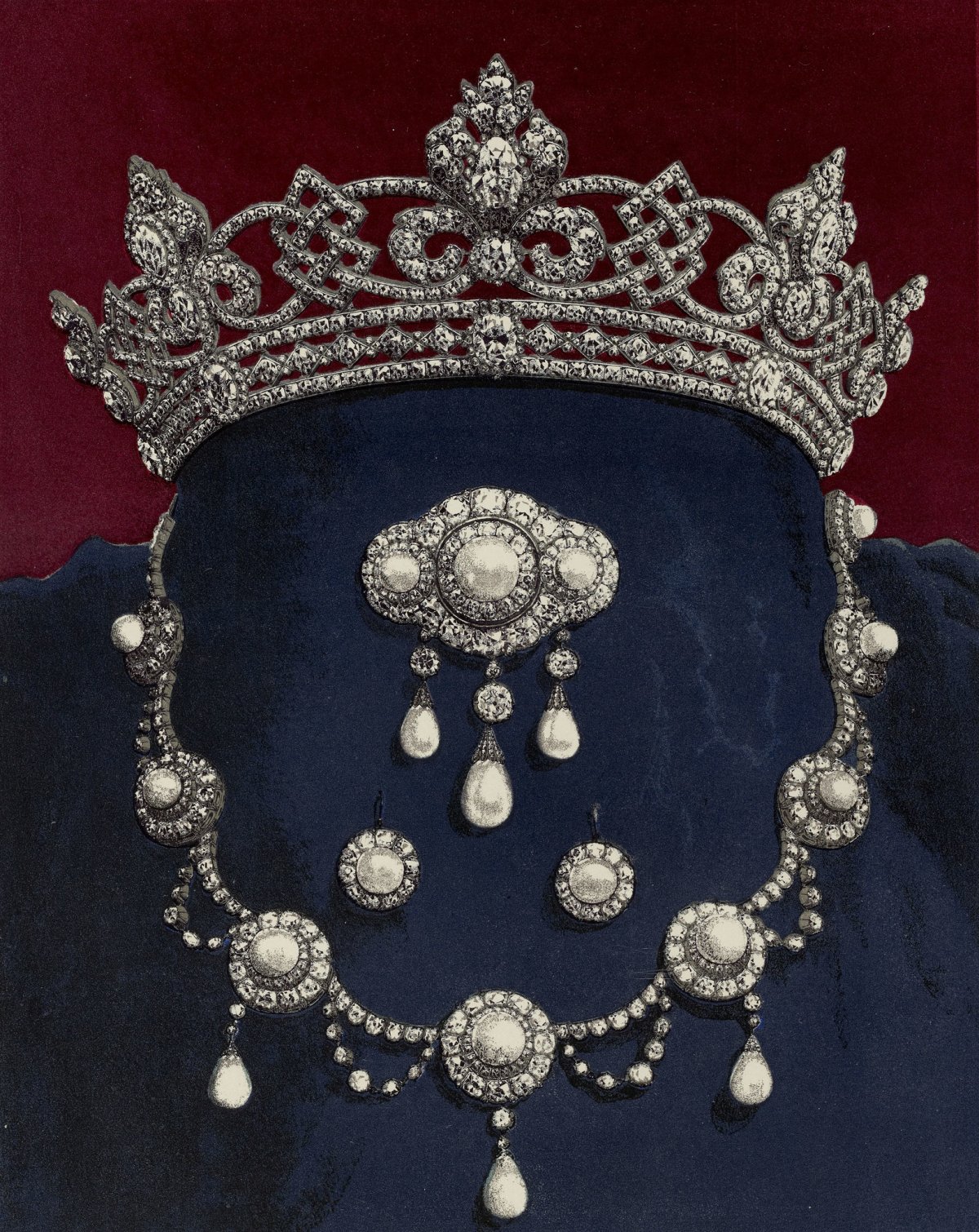
As the preparations were made for the wedding, Bertie presented his bride-to-be with a special gift: a lavish suite of diamond and pearl jewels. A contemporary illustration of the suite is presented above. The prince ordered the necklace and brooch (and presumably also the matching earrings) from Garrard, as was described in several newspapers (including the Liverpool Mercury) at the time of the wedding: “Messrs. Garrard, the Crown jewellers and goldsmiths, in the Haymarket, London, have prepared a magnificent necklace and brooch, which the Prince of Wales will present to the Princess Alexandra as a wedding gift. The necklace, a splendid triumph of the diamond setter’s art, is composed of eight clusters, with very large pendants surrounding diamonds. The centre clusters are composed of three very fine pear-shaped pearl drops, the whole connected by festoons of diamonds. The brooch is composed of magnificent pearls, surrounded by diamonds, with three other beautiful pearls forming drops. The two centre pearls are, indeed, of matchless beauty. These two splendid and most costly articles are composed of the choicest diamonds and pearls, and it would be difficult to find their fellows for match and brilliancy. The diamonds are all perfectly new, and were cut for the purpose of working out the design, while the pearls are of the choicest and most delicate hue.”
The set, the papers explained, was commissioned by Bertie himself: “The necklace and brooch were manufactured under the personal superintendence of the Prince of Wales. They were commenced soon after the prince arrived from Germany at the close of last year, and the whole of the time subsequent to that period has been occupied in completing the work. They will probably be worn by the Princess Alexandra as the principal part of her royal highness’s bridal adornments. This magnificent and right royal bridal gift is enclosed in a handsome dark-coloured velvet casket, on the outer part of which are the cipher and crown of her royal highness in gold.”
You’ll note that the illustration above also includes a tiara. It turns out that, although the tiara was made at the same time as the rest of the diamond and pearl set, and also given to Alix by Bertie as a wedding present, it wasn’t really intended to be part of a matched parure. It’s also described in the contemporary newspaper articles: “Messrs. Garrard are also making for the princess a diamond tiara of still greater magnificence. The centre ornament will be somewhat in the shape of the Prince of Wales’s feathers, with very large diamond drops in each. The band which forms the support to the feathers is studded with very large and fine diamonds. This also is a present from the prince to his bride.”
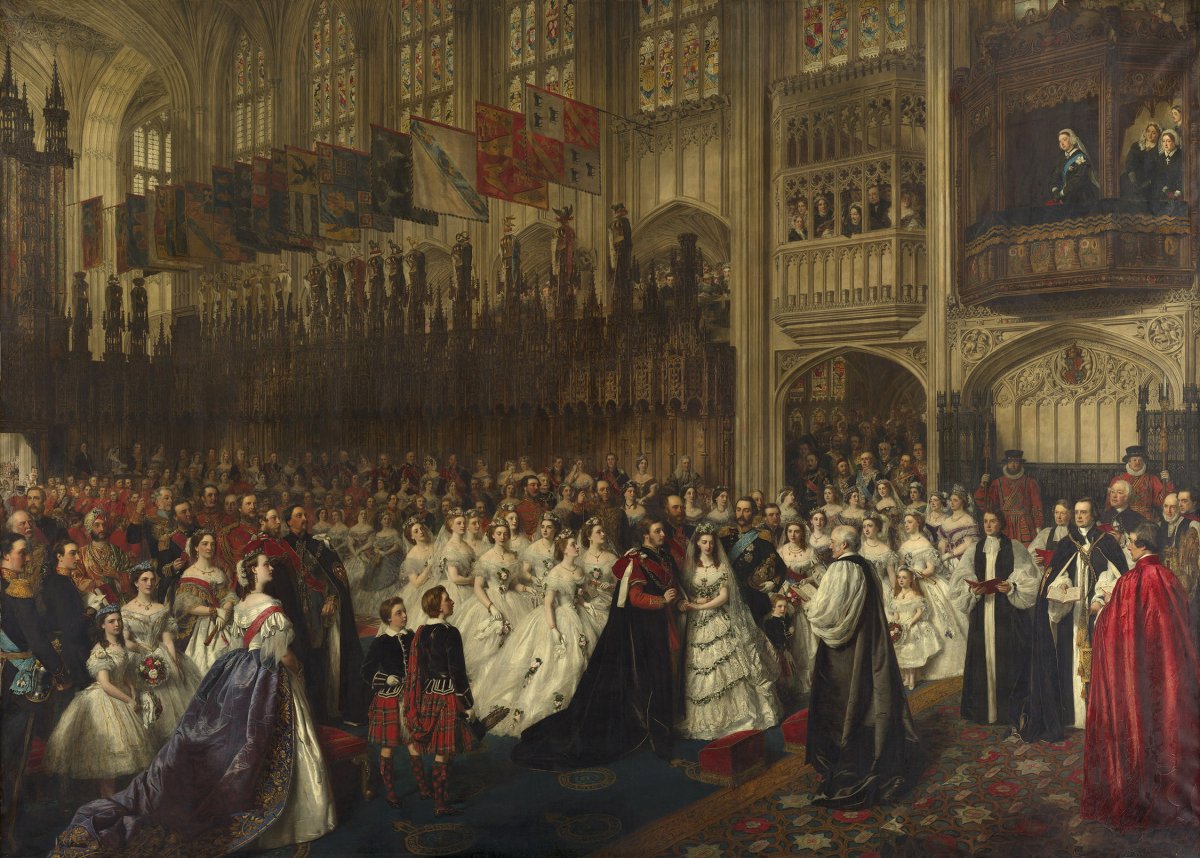
Per Queen Victoria’s wishes, Bertie and Alix were married at St. George’s Chapel, Windsor on March 10, 1863, in front of a large crowd of family members and dignitaries. Queen Victoria did indeed watch the nuptials from a perch high above the altar, hovering over the couple and the crowd. The groom’s family was represented by his mother, seven of his siblings (excluding Prince Alfred, who was recovering in a naval hospital in Malta after coming down with a fever while abroad), and his two brothers-in-law, as well as various aunts, uncles, and cousins. (Another notable family attendant: the groom’s four-year-old nephew, Prince Wilhelm of Prussia, who would later make history as Kaiser Wilhelm II.) Princess Alexandra’s parents and her five siblings were also present for the ceremony, which was conducted by the Archbishop of Canterbury, Thomas Longley. The train of Alexandra’s gown was carried by eight aristocratic bridesmaids.
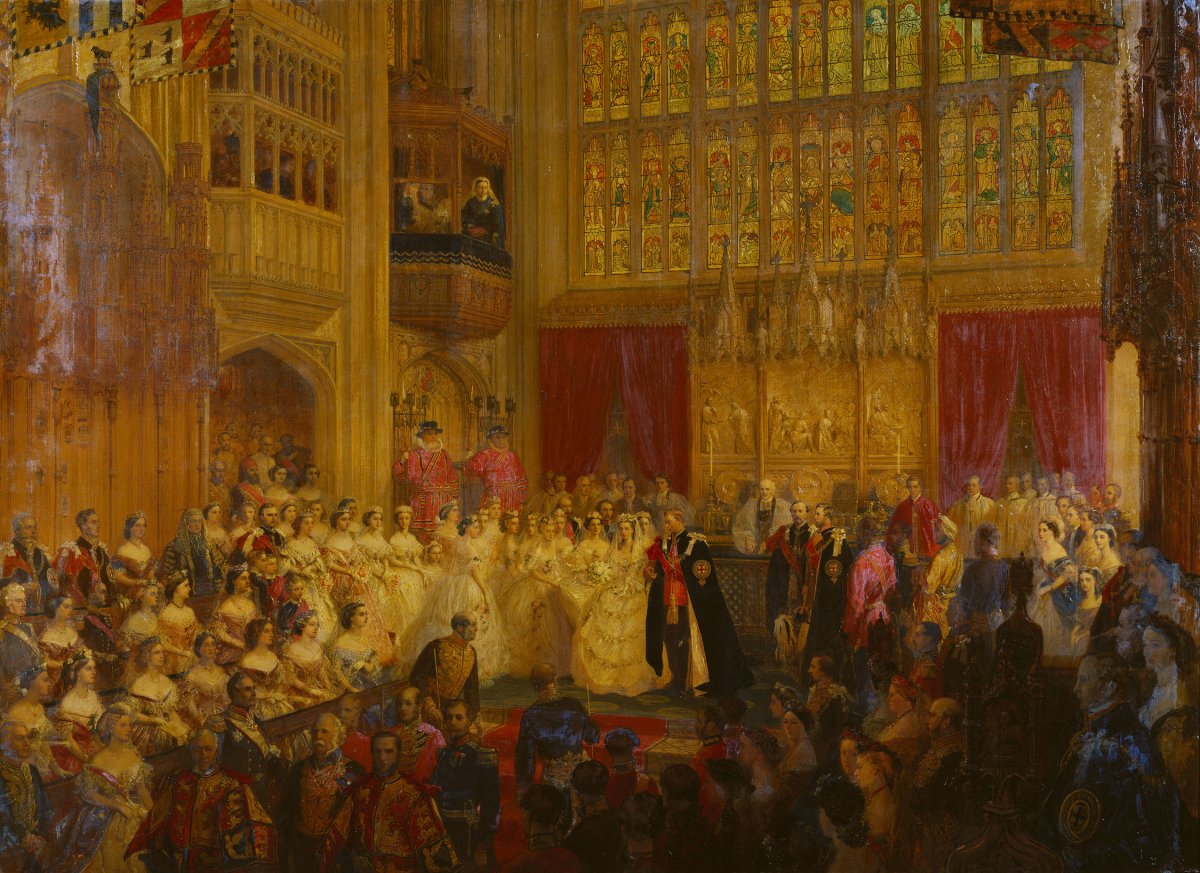
At least two artists were commissioned to produce paintings of the scene of the wedding. William Powell Frith painted one vantage point, while George Housman Thomas depicted a later moment in the proceedings. (Queen Victoria expressed a clear preference for Thomas’s painting, stating that it “is as good as poor Mr. Frith’s is bad.” She ended up owning both paintings anyway.)
Newspapers also offered pen portraits of the day. The Daily News captured a striking image of the end of the ceremony: “The Archbishop gave his blessing with great earnestness and solemnity, and was heartily joined in it by every person in the church. Whilst it was being delivered her Majesty the Queen knelt and prayed with her head buried in her handkerchief; and it was not unreasonable to conjecture that the sorrow of the widow mingled with the joy of the mother in producing the emotion which even the restraints of royal etiquette could not entirely conceal. In another moment the whole of this imposing ceremonial was over, the various processions retired nearly in the order in which they had advanced, and in an incredibly short space of time St. George’s Chapel resumed its ordinary stillness and solemnity.”
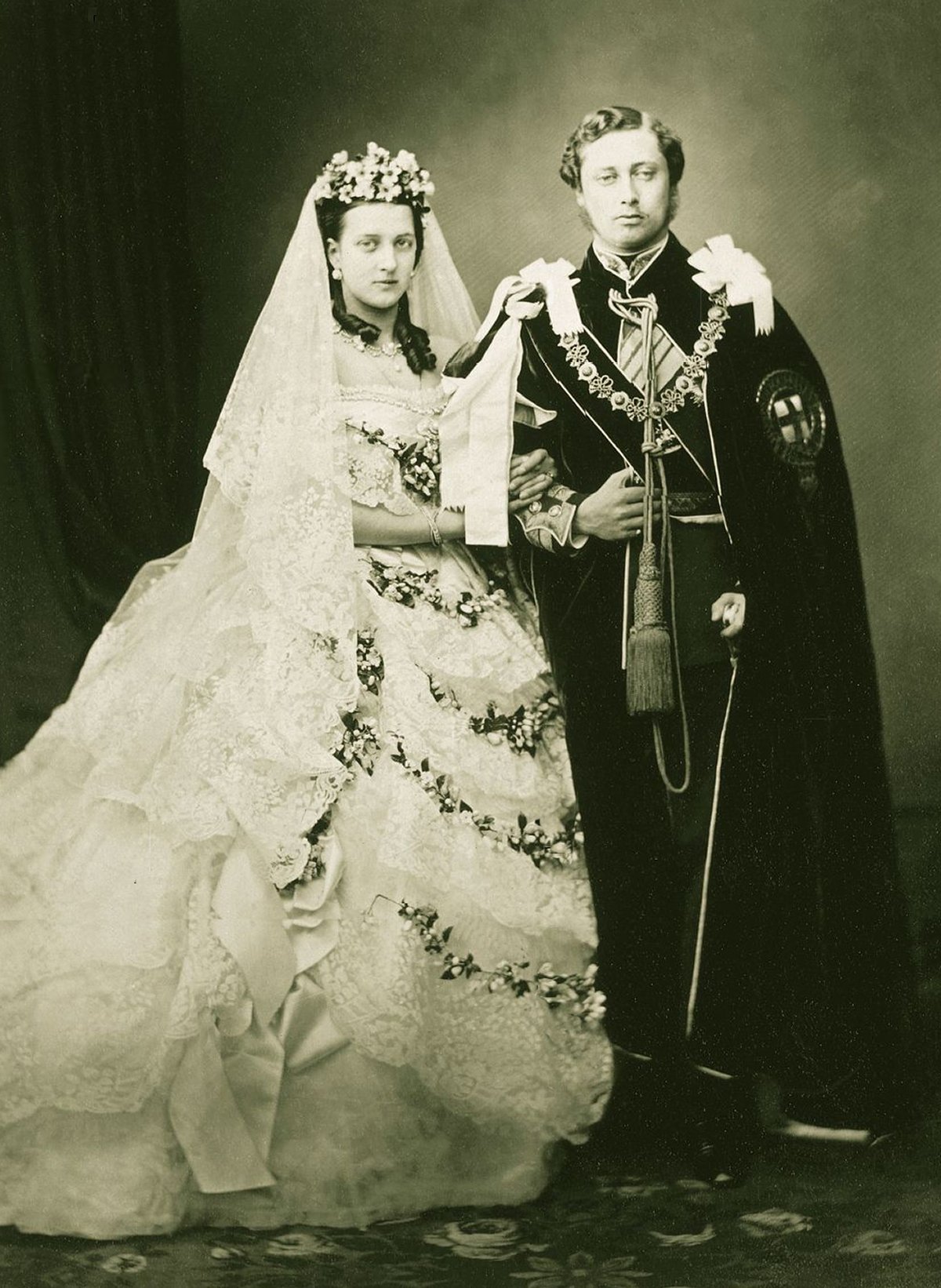
The wedding was also one of the first major British royal wedding to be thoroughly documented with photographs. Here, the Prince and Princess of Wales are shown in their wedding attire in a photograph by John Jabez Edwin Mayall. Bertie wore his Garter robes for the wedding, while Alix wore a confection of silk satin, tulle, and lace, made by Mrs. James of Belgravia. (Bertie’s uncle, King Leopold, had offered her a dress of Brussels lace, but a more patriotic gown from UK manufacturers and designers was diplomatically selected instead.) Festoons of orange blossoms and myrtle decorated the gown as well.
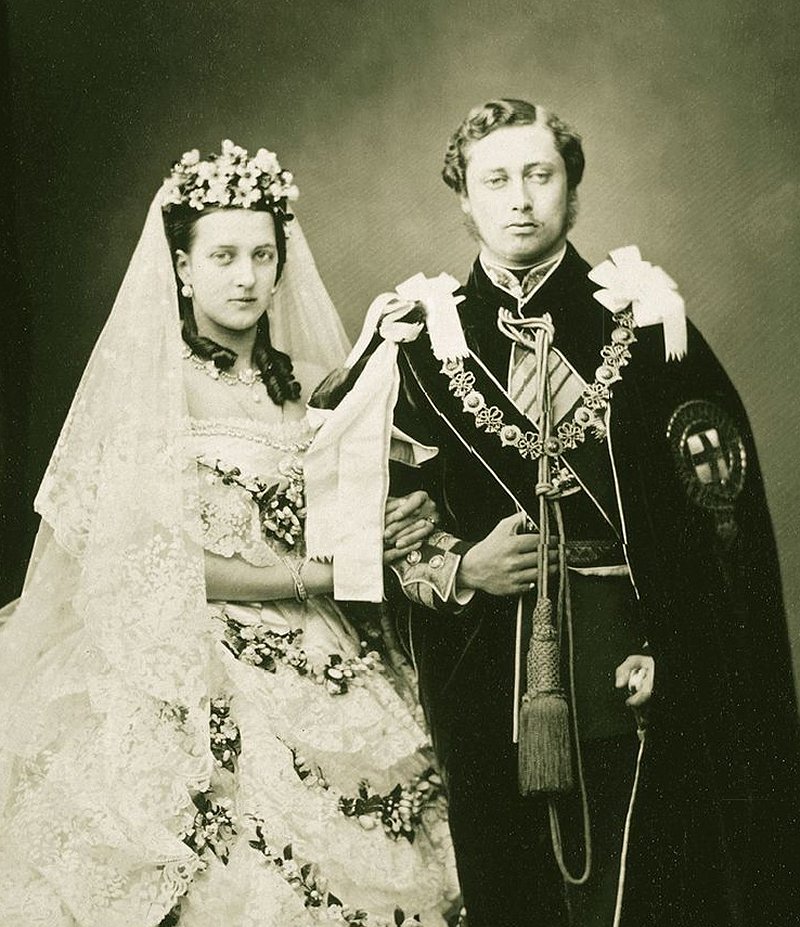
Alix also wore a crown of orange blossoms, not a tiara, to secure her lace veil. And as predicted, she accessorized with pieces from the jewelry suite that had been given to her by her new husband. You can see the earrings, the necklace, and the brooch in this wedding photograph. She also wore a special bracelet set with diamonds and opals—the favorite gem of the late Prince Consort—given to her by her new mother-in-law, Queen Victoria. Two more bracelets, gifts from committees of ladies from Leeds and Manchester, were added as well, and her new wedding ring completed the bejeweled ensemble.
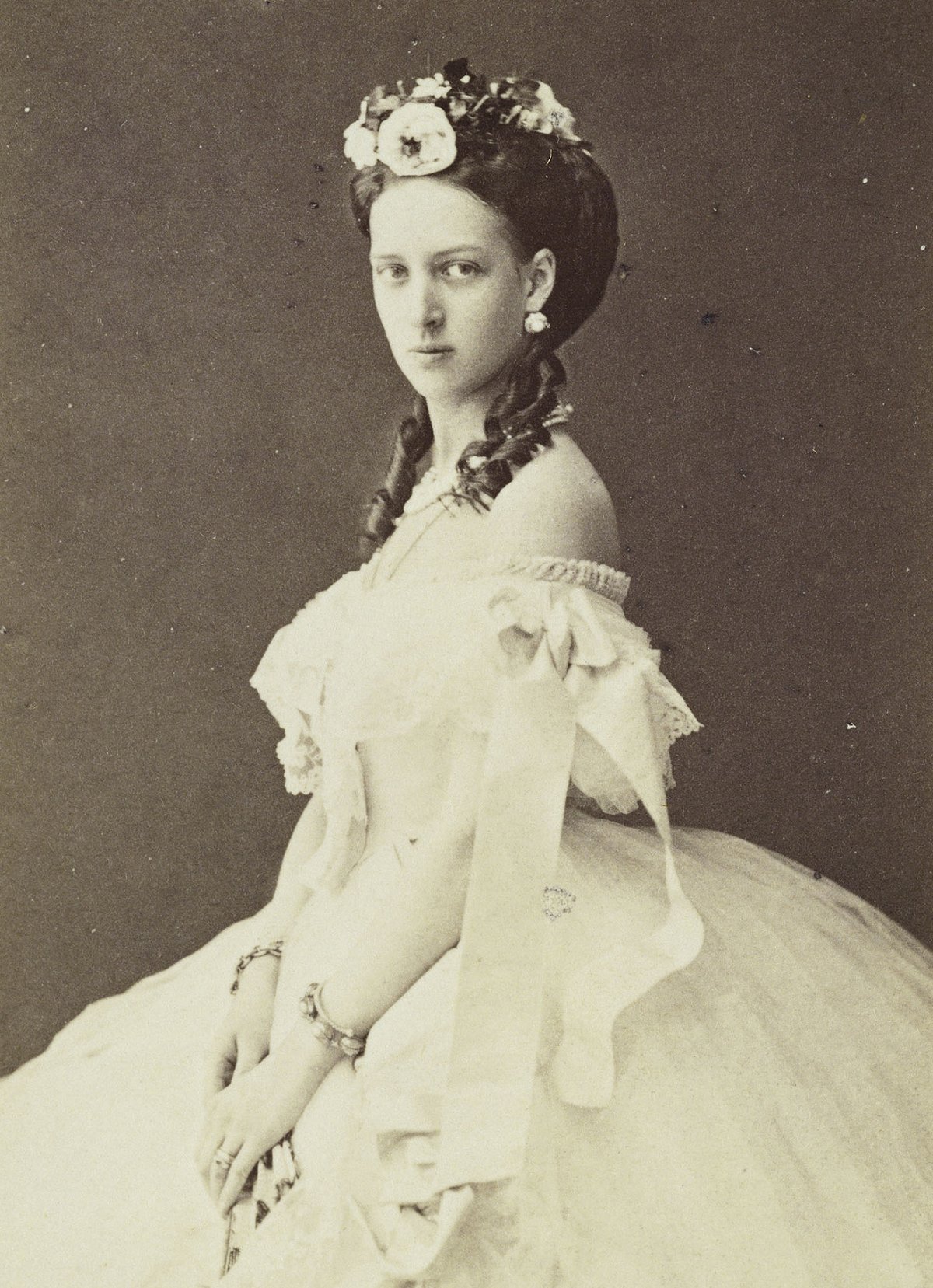
Alix would wear pieces from her diamond and pearl wedding gift suite for decades to come, both as Princess of Wales and later as Queen. She wears the earrings from the set in this striking portrait photograph, taken in 1864, just a year after her royal wedding.
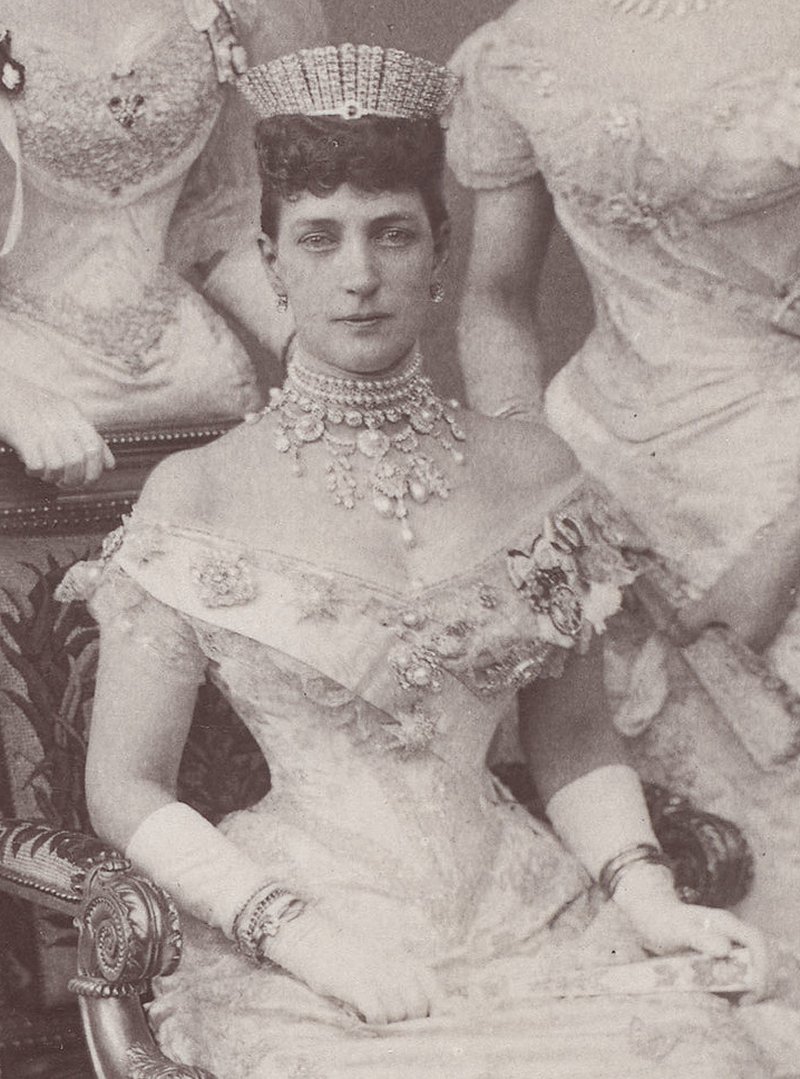
Here, you’ll spot the necklace from the set (worn with extra pendants) in a photograph taken at the wedding of her second son, King George V, in 1893. The brooch from the set is also here, without its pendants, pinned at an angle on her order sash. The tiara is a separate piece, a silver anniversary gift designed to look like one of her sister’s Russian kokoshniks.
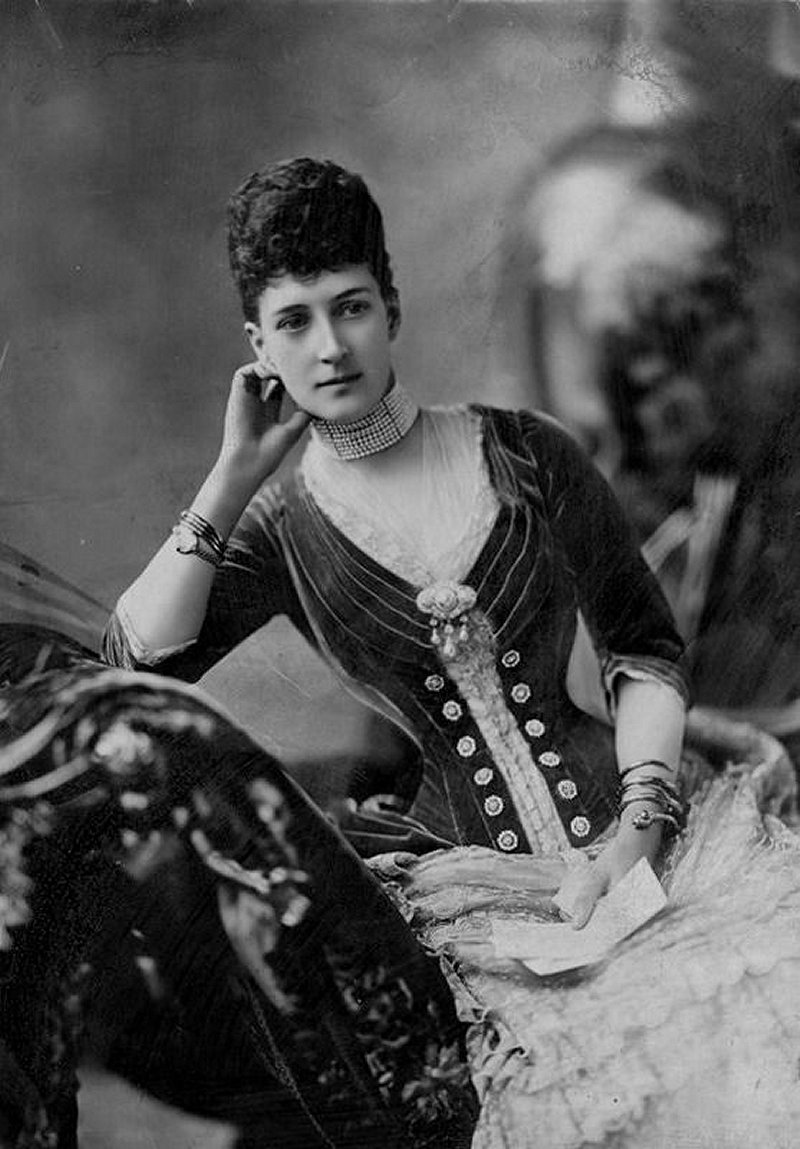
The brooch is also visible, with its pendants, in this portrait of Alix that also dates to the 1890s.
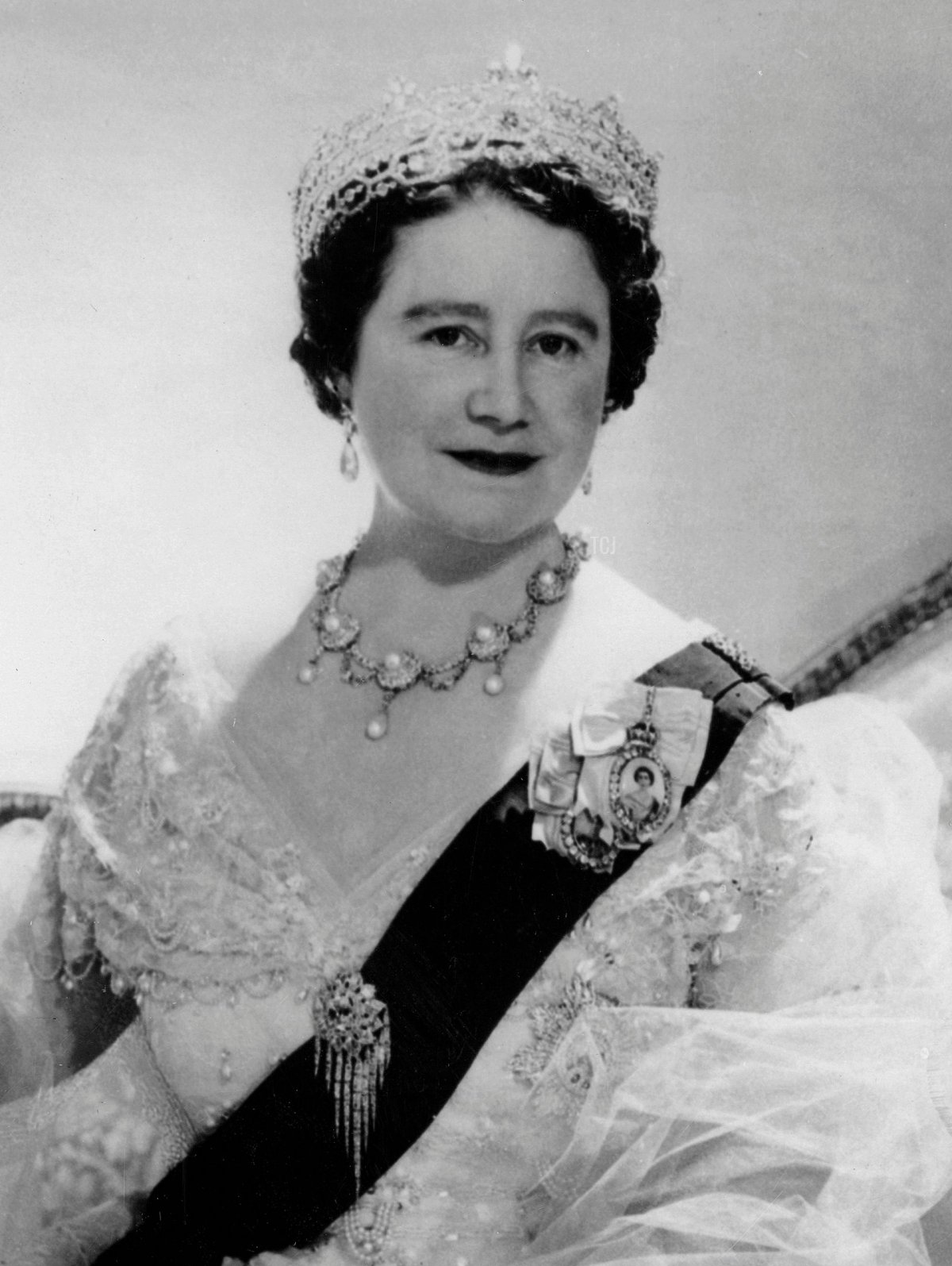
After Alexandra’s death in 1925, the necklace, earrings, and brooch were inherited by her daughter-in-law, Queen Mary. The diamond tiara gifted to Alix at the same time was inherited by her second daughter, Princess Victoria, and eventually left royal hands entirely. The diamond and pearl wedding jewels, however, have stayed with the main line of the family.
Queen Mary gave the necklace to her own daughter-in-law, Queen Elizabeth the Queen Mother, who treasured it throughout her lifetime. It was easily one of her most-worn pieces of royal jewelry. In the portrait above, which dates to 1957, she wears the necklace with the Greville Tiara, the Greville Peardrop Earrings, and Queen Victoria’s Diamond Fringe Brooch.
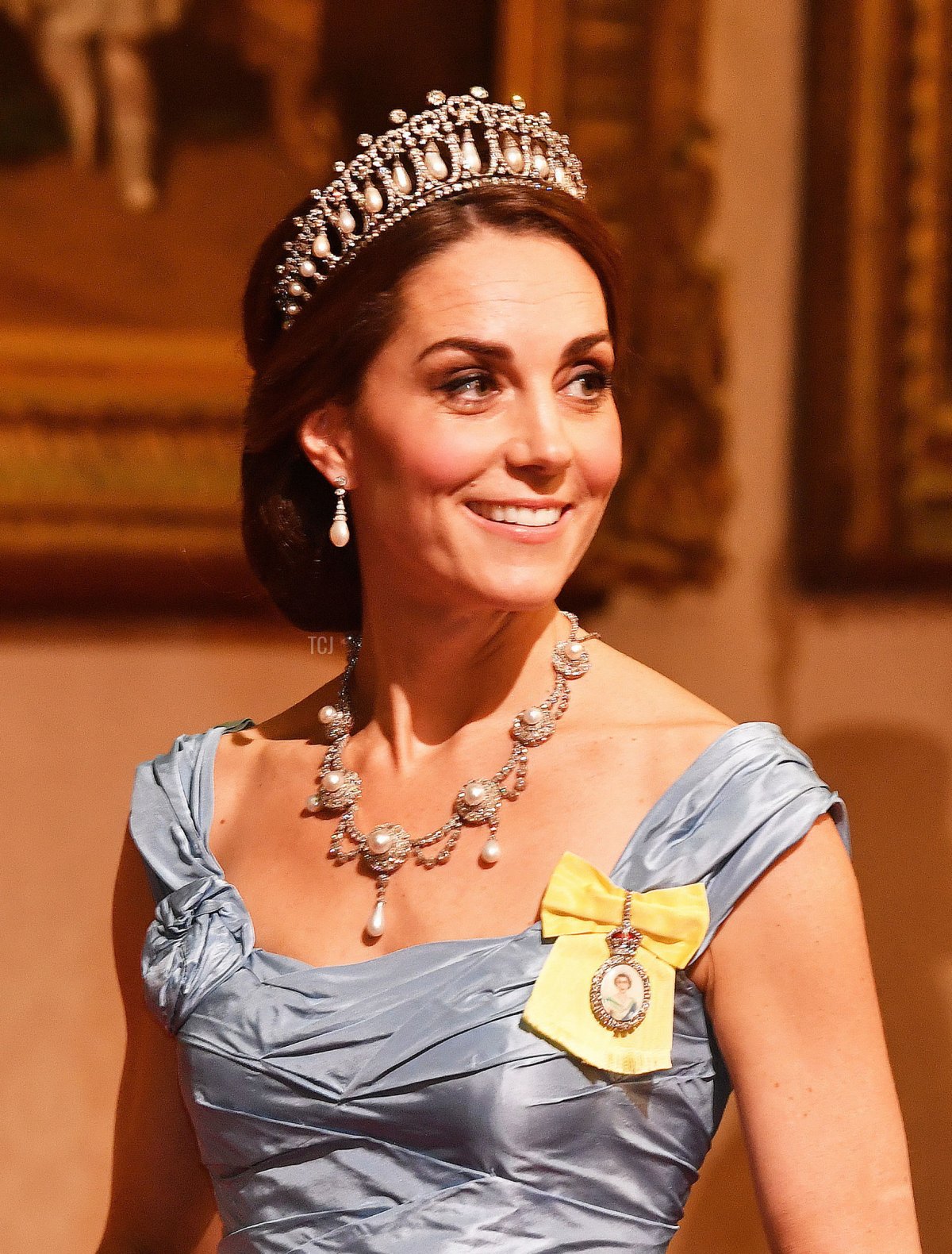
Most recently, Queen Alexandra’s Wedding Necklace was worn by the Duchess of Cambridge. She’s now the present holder of Alexandra’s long-standing title, Princess of Wales. For the Dutch state banquet at Buckingham Palace in October 2018, she paired the necklace with Queen Mary’s Lover’s Knot Tiara and Diana’s Collingwood Pearl Drop Earrings.
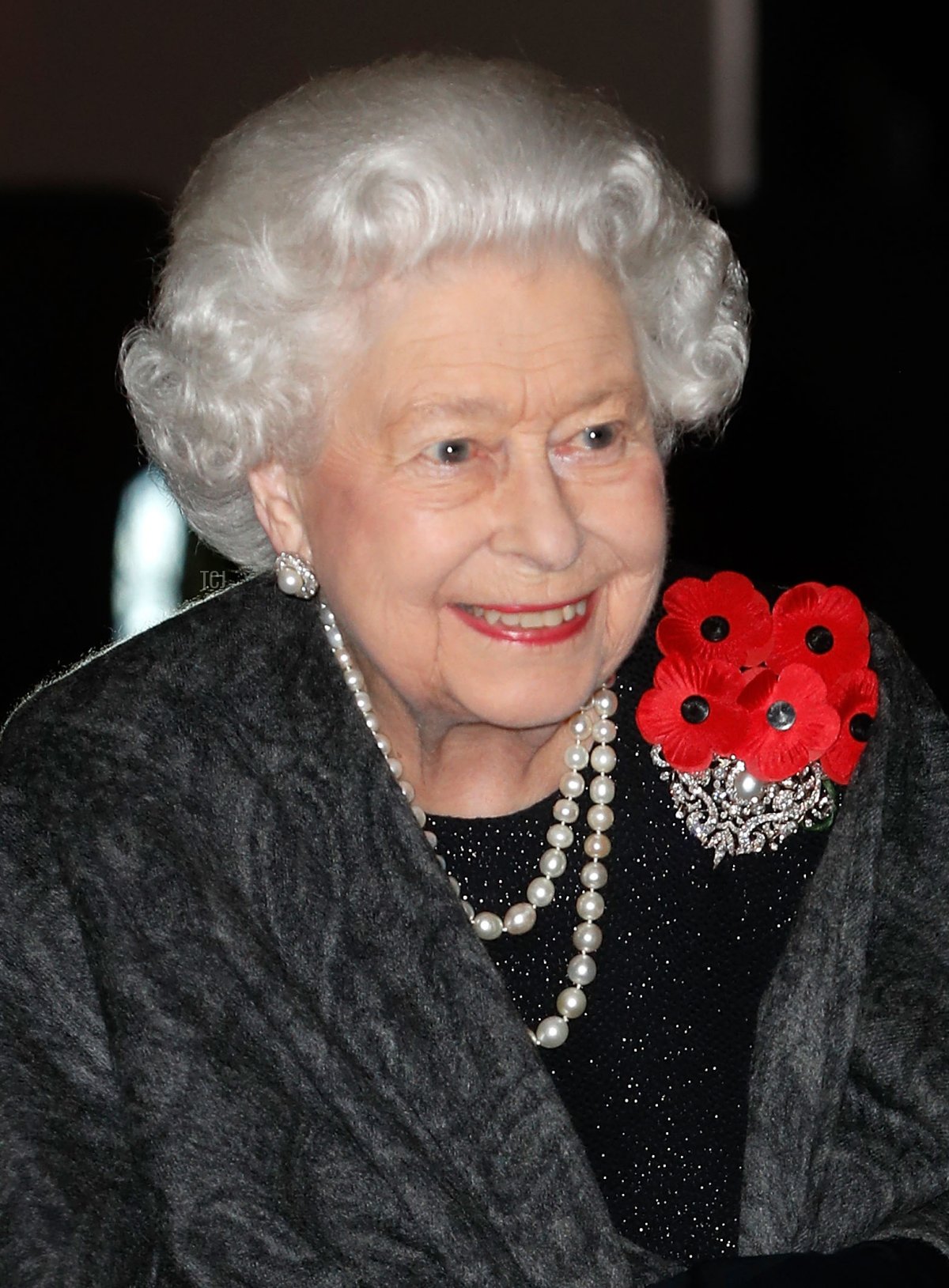
In 1953, Queen Elizabeth II inherited Queen Alexandra’s Wedding Earrings and Wedding Brooch from her grandmother, Queen Mary. She wore them occasionally over the next seven decades. Above, you’ll note the earrings, worn by Elizabeth for the Festival of Remembrance in 2018 with pearls and Queen Mary’s Richmond Brooch.
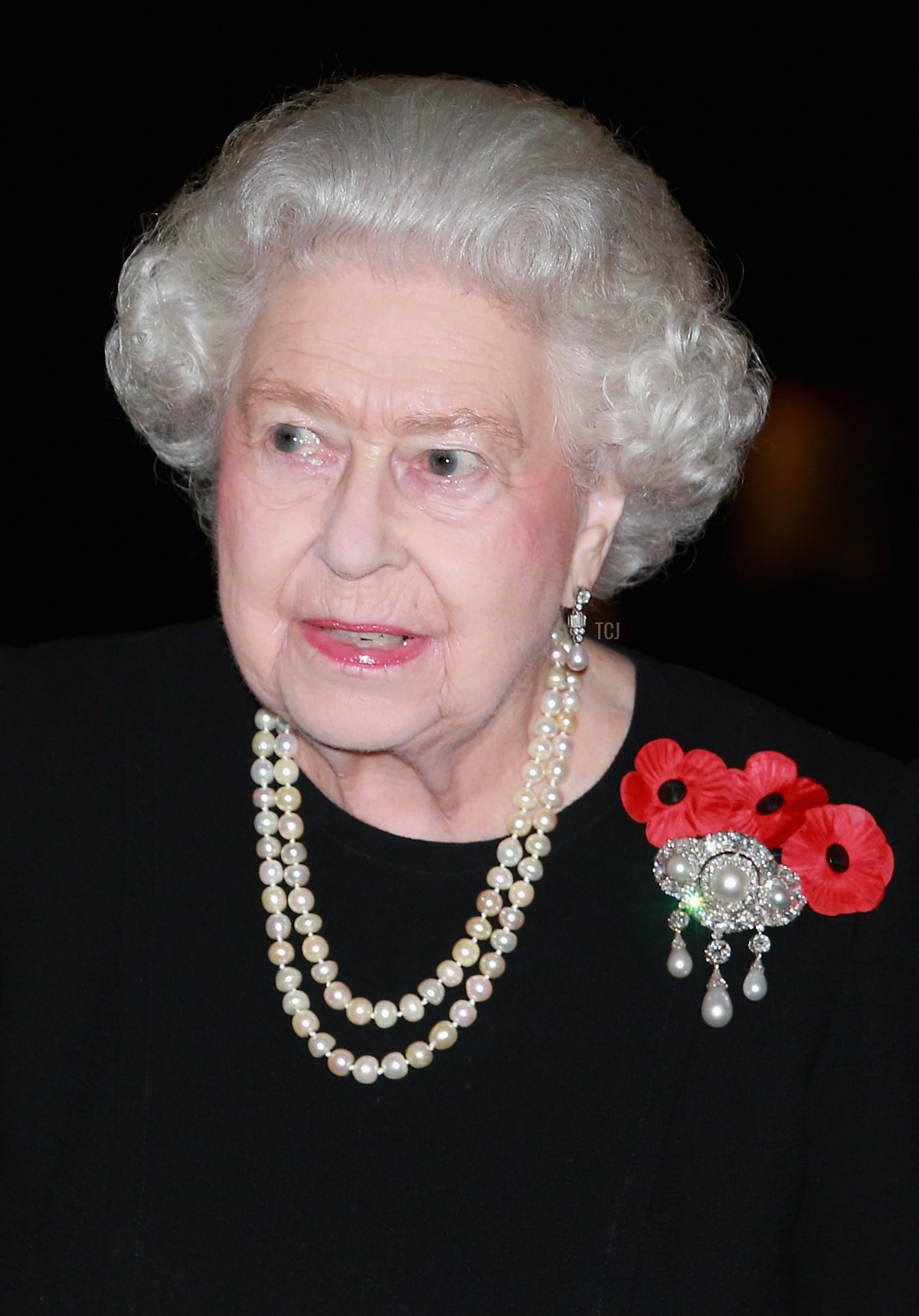
And here, in a photograph from the same event in November 2015, Elizabeth wears the wedding brooch (with its pendants) with pearls and the Bahrain Pearl Drop Earrings. It will be interesting to see who wears the earrings and brooch next. Queen Camilla doesn’t have pierced ears, so Kate would be the natural choice to be the next wearer of the wedding earrings. And, after all, she’s a devoted fan of pearls. Will we see her wear the wedding brooch as well?
Leave a Reply
You must be logged in to post a comment.